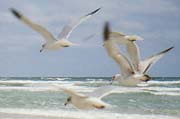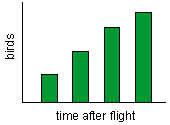 |
 |
Introduction Teachers Guide
Insects Birds Bats Pterosaurs Fish Wing Structures
Gliding Soaring Flapping Migration
Seed Helicopter Build a Bird
Ornithopter Zone Web Site Links |
Science Fair Ideas Looking for a science fair project that will stand out from the crowd? Flapping-wing flight offers many opportunities for school science fair projects. In fact, high school students can carry out significant new research that will advance our understanding of flapping wings. This may not be the case in other fields, which have been more fully studied. Many of these projects involve ornithopters, which are machines designed to flap their wings and fly like a real bird. This is the hands-on approach to bird flight, and it allows all kinds of experiments we could never do with real birds. Visit The Ornithopter Zone for more info that will be useful for your science fair project. Projects can be adapted to suit a large or small budget. Many science fairs require that you have a hypothesis and conduct an experiment to determine whether or not your hypothesis is correct. (It doesn't matter whether the hypethesis turns out to be true or false. What matters is that you use appropriate methods to determine whether it is true or false.) Other science fairs allow you to address an engineering problem without having to do a formal experiment. Make sure you know the rules before choosing a project. We've listed some project ideas, and we've separated them, depending on whether the project is an experiment or engineering task. Science Fair Experiments
A variety of
experiments could be used to assess the potential use of ornithopters
for bird control. You
need to choose an objective way of measuring how the birds react.
You could
go to a field or beach where gulls or geese gather, fly an RC ornithopter
there, and measure how quickly the birds return after the flight.
You might
want to get
permission from the parks department before conducting experiments
like this in a local park. You want the authorities to know you
are conducting an experiment and not harassing wildlife. Your activities
will not harm the birds.
If you don't have the funds to work with real ornithopters in an outdoor setting, you could show artificial stimuli to a pet bird to assess how it reacts to various characteristics, such as flapping rate. 2. Test an alternative flapping mechanism or wing design to see how it affects flight performance. For this project, you could use inexpensive, rubber-band-powered ornithopters. Flight time is an accepted method for comparing performance of different designs. You must control for weather conditions, weight differences, etc. You can also test wings on a bench setup without actually having to build a whole ornithopter that can fly.
3. Factors in wing design that affect ornithopter stability. Most ornithopters have a flat tail like a bird, instead of having a vertical tail fin or rudder like you see on airplanes. Some wing designs seem to require a vertical fin. It might have to do with where the wing twists: near the base for stability, or farther out causing instability and reduced performance.
Science Fair Engineering Tasks For any of these science and engineering fair projects, you would begin by doing some background research to find out how birds or insects have solved the same problem. 1. Develop an ornithopter capable of stable hovering flight. This could be radio controlled, or it could be a rubber-band-powered freeflight model. Either way, you can experiment with various ways of making the ornithopter more stable. 2. Design and build a device that would allow an ornithopter to perch on a limb. This is something no one has done yet, but once we solve the hovering problem it will be the next step. And you could bypass the hovering issue and just work on perching. Just swing the perching apparatus on a cord so that it reaches the perch with a known speed and direction. 3. Develop a flexible foam wing for ornithopters. Compare this with traditional fabric wings. 4. Develop an original wing design that more closely mimics a real bird or insect wing. 5. Develop an effective roll-control system for an ornithopter. Airplanes use wing flaps called ailerons to bank left and right for turns. Ornithopters generally rely on their tails for turning, and this limits their maneuverability. Roll control could be achieved by changing the shape or stiffness of the wings, or by changing how they flap. More ideas? If you have other ideas you would like to share, contact us and we can add them to the web site. |
||||||||
 1.
Flapping-Wing Aircraft for Bird Control. Flocks of birds are a safety
hazard at airports. They can damage airplanes, and they have even
caused fatal crashes. Birds can be scared away using a variety of
methods, including trained falcons, which chase the birds. Falcons
don't always cooperate though, so a radio-controlled ornithopter
or flapping-wing aircraft offers the possibility for more effective
bird control. That is, if the birds can be effectively driven away
by something that is not a real predator.
1.
Flapping-Wing Aircraft for Bird Control. Flocks of birds are a safety
hazard at airports. They can damage airplanes, and they have even
caused fatal crashes. Birds can be scared away using a variety of
methods, including trained falcons, which chase the birds. Falcons
don't always cooperate though, so a radio-controlled ornithopter
or flapping-wing aircraft offers the possibility for more effective
bird control. That is, if the birds can be effectively driven away
by something that is not a real predator.
